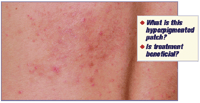A teenager looks over his shoulder and finds more than acne
What's the cause of a hyperpigmented patch on an adolescent boy's back?
A 15-year-old boy is brought to your office with a complaint of acne on his face and back, of four-to-six months' duration, that has been unresponsive to over-the-counter medications. A full skin examination reveals multiple erythematous papules bilaterally on the face and a few comedones on the forehead and cheeks.
You also note a hyperpigmented patch, approximately 6 cm by 3 cm and with an irregular border, on the left lower scapular region of the back (see the photograph). Erythematous macules, papules, and hair growth are localized in this area.
On questioning, the patient's mother reports that the patch has been present for one year but has not grown. She, and the boy, have noticed-as you do-that acne lesions are more prominent in the area of the hyperpigmented patch.

Diagnosis: Becker's nevus (with acne vulgaris and limb asymmetry)

The patch expands during the first several years as new irregular, pigmented macules and patches develop at the periphery and coalesce with the larger patch.2 In most cases, hyperpigmentation is followed, in approximately two years, by hypertrichosis, both within and in close proximity to the patch. Acne vulgaris may develop in association with prominent hair follicles. Becker's nevus appears most often on the shoulders, anterior chest, and scapulae, as well as on the trunk, forearms, buttocks, wrists, and shins.1
The prevalence of Becker's nevus is about 0.5%; the condition is five times more common in males than in females.3 Although most affected children are otherwise healthy, several associated anomalies have been described, including breast hypoplasia, limb asymmetry (as noted in this patient; see the photograph), unilateral or ipsilateral pectoralis major aplasia, ipsilateral limb shortening, ipsilateral foot enlargement, spina bifida, scoliosis, pectus carinatum, localized lipoatrophy, congenital adrenal hyperplasia, polythelia, and accessory scrotum.1 The relationship of these associated findings to the hyperpigmented patch is unknown.
Becker's nevus may be confused with café-au-lait spot, postinflammatory hyperpigmentation, and congenital nevus. When typical features are present, however, the diagnosis is evident.
Histopathologic characteristics and pathogenesis
Investigators have proposed that local androgen hyperactivity is the primary trigger of Becker's nevus.4 Familial cases have been described and genetic predisposition is a possibility.1 Histologically, there is mild acanthosis and hyperkeratosis, with regular elongation of rete ridges in the epidermis.2 The basal layer is marked by increased melanin, leading to hyperpigmentation. Melanosomes may be increased in keratinocytes. Hypertrichosis is the result of increased follicles. There is an increase in dermal smooth muscle.
Becker's nevus is a benign condition, without an increase in melanocytes or nevus cells. Malignant transformation has not been reported.1
Treatment
Becker's nevus persists indefinitely. Treatment is required only in response to cosmetic considerations. Although laser treatment may be helpful, most lesions recur. Use of sunscreen during periods of sun exposure during the summer may minimize further hyperpigmentation. Associated acne usually responds to a topical retinoid.
REFERENCES
1. Hurwitz S: Hurwitz Clinical Pediatric Dermatology: A Textbook of Skin Disorders of Childhood and Adolescence, ed 2. Philadelphia, W. B. Saunders, 1993; pp 210, 211
2. Rivers JK, Wiseman MC: Becker melanosis. eMedicine (2005). Available at http://www.imedicine.com.libproxy2.umdnj.edu/printtopic.asp?bookid=2&topic=48 Accessed Aug 12, 2006
3. Agrawal S, Garg VK, Sah SP, et al: Acne in Becker's nevus. Int J Dermatol 2001;40:583
Please see Dr. Cohen's Web site, http://www.dermatlas.org/, for additional images
Having "the talk" with teen patients
June 17th 2022A visit with a pediatric clinician is an ideal time to ensure that a teenager knows the correct information, has the opportunity to make certain contraceptive choices, and instill the knowledge that the pediatric office is a safe place to come for help.
Meet the Board: Vivian P. Hernandez-Trujillo, MD, FAAP, FAAAAI, FACAAI
May 20th 2022Contemporary Pediatrics sat down with one of our newest editorial advisory board members: Vivian P. Hernandez-Trujillo, MD, FAAP, FAAAAI, FACAAI to discuss what led to her career in medicine and what she thinks the future holds for pediatrics.